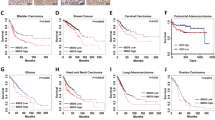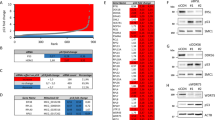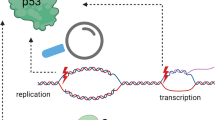Abstract
Data on the relationship between ribosome biogenesis and p53 function indicate that the tumour suppressor can be activated by either nucleolar disruption or ribosomal protein defects. However, there is increasing evidence that the induction of p53 does not always require these severe cellular changes, and data are still lacking on a possible role of ribosome biogenesis in the downregulation of p53. Here, we studied the effect of the up- and downregulation of the rRNA transcription rate on p53 induction in mammalian cells. We found that a downregulation of rRNA synthesis, induced by silencing the POLR1A gene coding for the RNA polymerase I catalytic subunit, stabilised p53 without altering the nucleolar integrity in human cancer cells. p53 stabilisation was due to the inactivation of the MDM2-mediated p53 degradation by the binding of ribosomal proteins no longer used for ribosome building. p53 stabilisation did not occur when rRNA synthesis downregulation was associated with a contemporary reduction of protein synthesis. Furthermore, we demonstrated that in three different experimental models characterised by an upregulation of rRNA synthesis, cancer cells treated with insulin or exposed to the insulin-like growth factor 1, rat liver stimulated by cortisol and regenerating rat liver after partial hepatectomy, the p53 protein level was reduced due to a lowered ribosomal protein availability for MDM2 binding. It is worth noting that the upregulation of rRNA synthesis was responsible for a decreased p53-mediated response to cytotoxic stresses. These findings demonstrated that the balance between rRNA and ribosomal protein synthesis controls the function of p53 in mammalian cells, that p53 can be induced without the occurrence of severe changes of the cellular components controlling ribosome biogenesis, and that conditions characterised by an upregulated rRNA synthesis are associated with a reduced p53 response.
This is a preview of subscription content, access via your institution
Access options
Subscribe to this journal
Receive 50 print issues and online access
$259.00 per year
only $5.18 per issue
Buy this article
- Purchase on Springer Link
- Instant access to full article PDF
Prices may be subject to local taxes which are calculated during checkout







Similar content being viewed by others
References
Abmayr SM, Yao T, Parmely T, Workman JL . (2006). Preparation of nuclear and cytoplasmic extracts from mammalian cells. Curr Protoc Mol Biol 12.1: 1–10.
Albrecht JH, Meyer AH, Hu MY . (1997). Regulation of cyclin-dependent kinase inhibitor p21(WAF1/Cip1/Sdi1) gene expression in hepatic regeneration. Hepatology 25: 557–563.
Arabi A, Wu S, Ridderstråle K, Bierhoff H, Shiue C, Fatyol K et al. (2005). c-Myc associates with ribosomal DNA and activates RNA polymerase I transcription. Nat Cell Biol 7: 303–310.
Barkić M, Crnomarković S, Grabusić K, Bogetić I, Panić L, Tamarut S et al. (2009). The p53 tumor suppressor causes congenital malformations in Rpl24-deficient mice and promotes their survival. Mol Cell Biol 29: 2489–2504.
Bates S, Phillips AC, Clark PA, Stott F, Peters G, Ludwig RL et al. (1998). p14ARF links the tumor suppressor RB and p53. Nature 395: 124–125.
Bensaad K, Vousden KH . (2007). p53: new roles in metabolism. Trends Cell Biol 17: 286–291.
Bernardi R, Scaglioni PP, Bergmann S, Horn HF, Vousden KH, Pandolfi PP . (2004). PML regulates p53 stability by sequestering Mdm2 to the nucleolus. Nat Cell Biol 6: 665–672.
Bhat KP, Itahana K, Jin A, Zhang Y . (2004). Essential role of ribosomal protein L11 in mediating growth inhibition induced p53 activation. EMBO J 23: 2402–2412.
Bilanges B, Argonza-Barrett R, Kolesnichenko M, Skinner C, Nair M, Chen M et al. (2007). Tuberous sclerosis complex protein 1 and 2 control serum-dependent translation in a TOP-dependent and -independent manner. Mol Cell Biol 27: 5746–5764.
Boisvert FM, Hendzel MJ, Bazett-Jones DP . (2000). Promyelocytic leukemia (PML) nuclear bodies are protein structures that do not accumulate RNA. Cell Biol 148: 283–292.
Burger K, Mühl B, Harasim T, Rohrmoser M, Malamoussi A, Orban M et al. (2010). Chemotherapeutic drugs inhibit ribosome biogenesis at various levels. J Biol Chem 285: 12416–12425.
Burns TF, El-Deiry WS . (1999). The p53 pathway and apoptosis. J Cell Physiol 181: 231–239.
Caldarola S, Amaldi F, Proud CG, Loreni F . (2004). Translational regulation of terminal oligopyrimidine mRNAs induced by serum and amino acids involves distinct signaling events. J Biol Chem 279: 13522–13531.
Cannata D, Fierz Y, Vijayakumar A, LeRoith D . (2010). Type 2 diabetes and cancer: what is the connection? Mt Sinai J Med 77: 197–213.
Chan PK, Qi Y, Amley J, Koller CA . (1996). Quantitation of the nucleophosmin/B23-translocation using imaging analysis. Cancer Lett 100: 191–197.
Dai MS, Lu H . (2004). Inhibition of MDM2-mediated p53 ubiquitination and degradation by ribosomal protein L5. J Biol Chem 279: 44475–44482.
Dai MS, Zeng SX, Jin Y, Sun XX, David L, Lu H . (2004). Ribosomal protein L23 activates p53 by inhibiting MDM2 function in response to ribosomal perturbation but not to translation inhibition. Mol Cell Biol 24: 7654–7668.
Deisenroth C, Zhang Y . (2010). Ribosome biogenesis surveillance: probing the ribosomal protein-Mdm2-p53 pathway. Oncogene 29: 4253–4260.
Derenzini M, Moyne G . (1978). The nucleolar origin of certain perichromatin-like granules: a study with alpha-Amanitin. J Ultrastruct Res 62: 213–219.
Derenzini M, Pession-Brizzi A, Betts-Eusebi C, Novello F . (1981). Relationship between the fine structural organization of chromatin and nucleic acid synthesis in regenerating rat hepatocytes. J Ultrastruct Res 75: 229–242.
Donati G, Brighenti E, Vici M, Mazzini G, Treré D, Montanaro L, Derenzini M . (2010). Selective inhibition of rRNA transcription downregulates E2F-1 expression: a new p53-independent mechanism linking cell growth to cell proliferation (submitted).
Frasca F, Pandini G, Sciacca L, Pezzino V, Squatrito S, Belfiore A et al. (2008). The role of insulin receptors and IGF-I receptors in cancer and other diseases. Arch Physiol Biochem 114: 23–37.
Fumagalli S, Di Cara A, Neb-Gulati A, Natt F, Schwemberger S, Hall J et al. (2009). Absence of nucleolar disruption after impairment of 40S ribosome biogenesis reveals an rpL11-translation-dependent mechanism of p53 induction. Nat Cell Biol 11: 501–508.
Gera JF, Mellinghoff IK, Shi Y, Rettig MB, Tran C, Hsu JH et al. (2004). AKT activity determines sensitivity to mammalian target of Rapamycin (mTOR) inhibitors by regulating cyclin D1 and c-myc expression. J Biol Chem 279: 2737–2746.
Glibetic M, Larson DE, Rothblum LI, Sells BH . (1993). Dexamethasone stimulates rRNA gene transcription in rat myoblasts. Mol Cell Endocrinol 94: 243–252.
Glibetic M, Taylor L, Larson D, Hannan R, Sells B, Rothblum L . (1995). The RNA polymerase I transcription factor UBF is the product of a primary response gene. J Biol Chem 270: 4209–4212.
Gong X, Kole L, Iskander K, Jaiswal AK . (2007). NRH:quinone oxidoreductase 2 and NAD(P)H:quinone oxidoreductase 1 protect tumor suppressor p53 against 20s proteasomal degradation leading to stabilization and activation of p53. Cancer Res 67: 5380–5388.
Grandori C, Gomez-Roman N, Felton-Edkins ZA, Ngouenet C, Galloway DA, Eisenman RN et al. (2005). c-Myc binds to human ribosomal DNA and stimulates transcription of rRNA genes by RNA polymerase I. Nat Cell Biol 7: 311–318.
Grewal SS, Li L, Orian A, Eisenman RN, Edgar BA . (2005). Myc-dependent regulation of ribosomal RNA synthesis during Drosophila development. Nat Cell Biol 7: 295–302.
Hannan KM, Brandenburger Y, Jenkins A, Sharkey K, Cavanaugh A, Rothblum L et al. (2003). mTOR-dependent regulation of ribosomal gene transcription requires S6K1 and is mediated by phosphorylation of the carboxy-terminal activation domain of the nucleolar transcription factor UBF. Mol Cell Biol 23: 8862–8877.
Hannan KM, Rothblum LI, Jefferson LS . (1998). Regulation of ribosomal DNA transcription by insulin. Am J Physiol 275: C130–C138.
Haupt Y, Maya R, Kazaz A, Oren M . (1997). Mdm2 promotes the rapid degradation of p53. Nature 387: 296–299.
Higgins G, Anderson R . (1931). Experimental pathology of the liver. 1. Restoration of the liver of the white rat following partial surgical removal. Arch Pathol 12: 186–202.
Hölzel M, Rohrmoser M, Schlee M, Grimm T, Harasim T, Malamoussi A et al. (2005). Mammalian WDR12 is a novel member of the Pes1-Bop1 complex and is required for ribosome biogenesis and cell proliferation. J Cell Biol 170: 367–378.
Jin A, Itahana K, O'Keefe K, Zhang Y . (2004). Inhibition of HDM2 and activation of p53 by ribosomal protein L23. Mol Cell Biol 24: 7669–7680.
Khutornenko AA, Roudko VV, Chernyak BV, Vartapetian AB, Chumakov PM, Evstafieva AG . (2010). Pyrimidine biosynthesis links mitochondrial respiration to the p53 pathway. Proc Natl Acad Sci USA 107: 12828–12833.
Kruger T, Zentgraf H, Scheer U . (2007). Intranucleolar sites of ribosome biogenesis defined by the localization of early binding ribosomal proteins. J Cell Biol 177: 573–578.
Kubbutat MH, Jones SN, Vousden KH . (1997). Regulation of p53 stability by Mdm2. Nature 387: 299–303.
Liu Y, Elf SE, Miyata Y, Sashida G, Liu Y, Huang G et al. (2009). p53 regulates hematopoietic stem cell quiescence. Cell Stem Cell 4: 37–48.
Livak KJ, Schmittgen TD . (2001). Analysis of relative gene expression data using real-time quantitative PCR and the 2−ΔΔCT method. Methods 25: 402–408.
Lohrum MAE, Ludwig RL, Kubbutat MHG, Hanlon M, Vousden KH . (2003). Regulation of HDM2 activity by the ribosomal protein L11. Cancer Cell 3: 577–587.
Lowe SW, Cepero E, Evan G . (2004). Intrinsic tumour suppression. Nature 432: 307–315.
Mahajan PB . (1994). Modulation of transcription of rRNA genes by Rapamycin. Int J Immunopharmacol 16: 711–721.
Meletis K, Wirta V, Hede SM, Nister M, Lundeberg J, Frisen J . (2006). p53 suppresses the self-renewal of adult neural stem cells. Development 133: 363–369.
Momand J, Zambetti GP, Olson DC, George D, Levine AJ . (1992). The mdm-2 oncogene product forms a complex with the p53 protein and inhibits p53-mediated transactivation. Cell 69: 1237–1245.
Montanaro L, Mazzini G, Barbieri S, Vici M, Nardi-Pantoli A, Govoni M et al. (2007). Different effects of ribosome biogenesis inhibition on cell proliferation in retinoblastoma protein- and p53-deficient and proficient human osteosarcoma cell lines. Cell Prolif 40: 532–549.
Montanaro L, Treré D, Derenzini M . (2008). Nucleolus, ribosomes, and cancer. Am J Pathol 173: 301–310.
Murayama A, Ohmori K, Fujimura A, Minami H, Yasuzawa-Tanaka K, Kuroda T et al. (2008). Epigenetic control of rDNA loci in response to intracellular energy status. Cell 133: 627–639.
Nadal C . (1995). Dose-related opposite effects of hydrocortisone on hepatocyte proliferation in the rat. Liver 15: 63–69.
O'Mahony DJ, Xie WQ, Smith SD, Singer HA, Rothblum LI . (1992). Differential phosphorylation and localization of the transcription factor UBF in vivo in response to serum deprivation. In vitro dephosphorylation of UBF reduces its transactivation properties. J Biol Chem 267: 35–38.
Panić L, Montagne J, Cokarić M, Volarević S . (2007). S6-haploinsufficiency activates the p53 tumor suppressor. Cell Cycle 6: 20–24.
Pestov DG, Strezoska Z, Lau LF . (2001). Evidence of p53-dependent cross-talk between ribosome biogenesis and the cell cycle: effects of nucleolar protein Bop1 on G(1)/S transition. Mol Cell Biol 21: 4246–4255.
Renehan AG, Frystyk J, Flyvbjerg A . (2006). Obesity and cancer risk: the role of the insulin-IGF axis. Trends Endocrinol Metab 17: 328–336.
Renehan AG, Roberts DL, Dive C . (2008). Obesity and cancer: pathophysiological and biological mechanisms. Arch Physiol Biochem 114: 71–83.
Rubbi CP, Milner J . (2003). Disruption of the nucleolus mediates stabilization of p53 in response to DNA damage and other stresses. EMBO J 22: 6068–6077.
Sax JK, El-Deiry WS . (2003). p53 downstream targets and chemosensitivity. Cell Death Differ 10: 413–417.
Sirri V, Roussel P, Trerè D, Derenzini M, Hernandez-Verdun D . (1995). Amount variability of total and individual Ag-NOR proteins in cells stimulated to proliferate. J Histochem Cytochem 43: 887–893.
Sulic S, Panic L, Barkic M, Mercep M, Uzelac M, Volarevic S . (2005). Inactivation of S6 ribosomal protein gene in T lymphocytes activates a p53-dependent checkpoint response. Genes Dev 19: 3070–3082.
Thompson NL, Mead JE, Braun L, Goyette M, Shank PR, Fausto N . (1986). Sequential protooncogene expression during rat liver regeneration. Cancer Res 46: 3111–3117.
Vassilev LT, Vu BT, Graves B, Carvajal D, Podlaski F, Filipovic Z et al. (2004). In vivo activation of the p53 pathway by small-molecule antagonists of MDM2. Science 303: 844–848.
Vogelstein B, Lane D, Levine AJ . (2000). Surfing the p53 network. Nature 408: 307–310.
Vousden KH, Lane DP . (2007). p53 in health and disease. Nat Rev Mol Cell Biol 8: 275–283.
Vousden KH, Prives C . (2009). Blinded by the light: the growing complexity of p53. Cell 137: 413–431.
Vousden KH, Ryan KM . (2009). p53 and metabolism. Nat Rev Cancer 9: 691–700.
Wu A, Tu X, Prisco M, Baserga R . (2005). Regulation of upstream binding factor 1 activity by insulin-like growth factor I receptor signaling. J Biol Chem 280: 2863–2872.
Zhang Y, Lu H . (2009). Signaling to p53: ribosomal proteins find their way. Cancer cell 16: 369–377.
Zhang Y, Wolf GW, Bhat K, Jin A, Allio T, Burkhart WA et al. (2003). Ribosomal protein L11 negatively regulates oncoprotein MDM2 and mediates p53-dependent ribosomal-stress checkpoint pathway. Mol Cell Biol 23: 8902–8912.
Acknowledgements
This work was supported by the Roberto and Cornelia Pallotti's Legacy for Cancer Research, the Vanini–Cavagnino Grant and the Italian Ministry of Education, University and Research (MIUR: grants for orientated fundamental research). We thank Professor U Scheer for the generous gift of the anti-ribosomal protein S14 antibody. We are indebted with Dr Maurizio Brigotti for performing polysomal fraction analysis.
Author information
Authors and Affiliations
Corresponding author
Ethics declarations
Competing interests
The authors declare no conflict of interest.
Additional information
Supplementary Information accompanies the paper on the Oncogene website
Supplementary information
Rights and permissions
About this article
Cite this article
Donati, G., Bertoni, S., Brighenti, E. et al. The balance between rRNA and ribosomal protein synthesis up- and downregulates the tumour suppressor p53 in mammalian cells. Oncogene 30, 3274–3288 (2011). https://doi.org/10.1038/onc.2011.48
Received:
Revised:
Accepted:
Published:
Issue Date:
DOI: https://doi.org/10.1038/onc.2011.48
Keywords
This article is cited by
-
KRAS-related long noncoding RNAs in human cancers
Cancer Gene Therapy (2022)
-
Multiomics approach reveals the ubiquitination-specific processes hijacked by SARS-CoV-2
Signal Transduction and Targeted Therapy (2022)
-
p53 at the crossroad of DNA replication and ribosome biogenesis stress pathways
Cell Death & Differentiation (2022)
-
Electronic cigarette smoke reduces ribosomal protein gene expression to impair protein synthesis in primary human airway epithelial cells
Scientific Reports (2021)
-
Targeting cancer via ribosome biogenesis: the cachexia perspective
Cellular and Molecular Life Sciences (2021)



